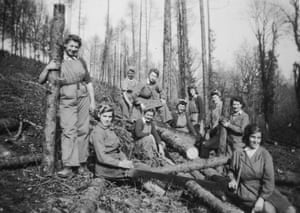Lumberjills Moving a Tree to Crosscut It, June 1944, Bardon Hill Woods, Leicestershire
During the second world war, young women broke traditional gender barriers by working in Britain’s forests as part of the Women’s Timber Corps. As many as 15-18,000 young women left home for the first time, aged 17-24, to fell trees with an axe and saw for the war effort – tasks typically thought of at the time as ‘men’s work’. The Lumberjills photo book by Joanna Foat is published by Merrow Downs Press
Photograph: Doris Youde Collection

Enormous Felled Tree, Surrey
Author Joanna Foat has spent the last decade searching for these rare photographs, many hidden away in attics for more than 80 years. They capture the strength, skill and camaraderie of these young women in roles traditionally dominated by men. The women could fell 10-tonne trees, carry logs like weight-lifters, work in dangerous sawmills, drive huge timber trucks and calculate timber production figures on which the government depended during wartime. They did exactly the same jobs as the men on less than half the pay
Photograph: Heather Harries Collection

Friends of Hazel Collins
‘Finding a large stash of photos felt like Christmas. Many show women having such fun working out in the forests doing exactly the same jobs as the men. They became physically very strong,’ writes Joanna Foat
Photograph: Hazel Collins Collection

Heather Harries and Friends on Haulage Tractor, Surrey
Heather Harries wrote home to tell her parents about her first 24 hours at Wetherby Timber Training Camp. ‘There seems to be an overwhelming amount to tell you! At the moment we are waiting in our bedroom clad in vest and pants for a medical inspection. It’s just like getting into the army.’ Heather went on to be trained as a measurer. ‘The measuring itself is quite easy, but there’s quite a lot of responsibility attached to the office work. We spend the afternoon in Wetherby Church Hall doing arithmetic chiefly’
Photograph: Heather Harries Collection

Kathleen Houghton Driving Haulage Truck
Britain was the largest timber importing nation in the world in 1939, bringing in 96% of its wood. When the war began, home grown timber supplies became vital. Britain needed to produce millions of tonnes of pit wood for the coal mines, as well as wood for railway sleepers, telegraph poles, rifle stocks, ship and aircraft construction, packaging boxes for bombs and army supplies, D-Day landing trackways and the floating Mulberry harbours
Photograph: Kathleen Houghton Collection

Kathleen Houghton
Before the war, Kathleen Houghton worked in the milk bar at Woolworths in Blackpool. In 1941, she joined the Women’s Timber Corps and trained as a lorry driver, even though she’d never driven a car before. During the war, she served in Lanhydrock and Lostwithiel, Cornwall, delivering urgent lorry loads of pit props for the coal mines to the station in Plymouth
Photograph: Kathleen Houghton Collection

Kathleen Houghton Driving Timber Haulage Truck
On one top secret mission, Kathleen was tasked with delivering wood destined for the floating Mulberry harbours through heavily bombed dock areas. The Mulberries were constructed in secrecy and floated into position immediately after the D-Day landings to unload thousands of tonnes of vehicles and supplies on to the Normandy beaches. Houghton finally obtained her car licence in the late 1950s. When the examiner asked if she had ever driven before, she explained her experience on timber haulage during the war and was passed immediately
Photograph: Kathleen Houghton Collection

Lumberjills Drinking Cider
An article in the Western Morning News in January 1940 said of the women that ‘it was not intended they should take the place of skilled men’. Even today, Foat points out, we need greater investment to encourage more women into these sectors
Photograph: Hazel Collins Collection

Tractor Driver Hauling Tree Into Mill Site, June 1944, Bardon Hill Woods, Leicestershire
Doris Youde was a forewoman appointed to oversee forestry operations for the clear-felling of a 300-acre wood at Castle Howard in the North Yorkshire Moors. Not only did she manage a large team of women from the Women’s Timber Corps, but she also ran a sawmill specifically established for this operation, and took charge of a clear-fell operation involving 29 men. Youde noted that the men did not like being given orders by a woman
Photograph: Doris Youde Collection

Office Staff, Lanhydrock Sawmill, 1945
Foat hopes the Lumberjills will inspire young women to explore unconventional career paths today, challenging gender norms and encouraging them to embrace their full potential. Many of the Lumberjills were promoted to supervisors and put in charge of whole forestry operations, including large teams of men. ‘The Lumberjills photo collection helps us to imagine a world where there is equality in career choice,’ writes Foat. ‘Where women are regarded as equal to men in all jobs and skilled trades’
Photograph: Kathleen Houghton Collection

Kathleen Houghton Driving Timber Haulage Truck
Joanna Foat is the author of the history book, Lumberjills: Britain’s Forgotten Army, and the first in a series of novels, The Lumberjills Stronger Together. She created The Lumberjills Story exhibition for Forestry England and has given more than 100 talks up and down the country. Alongside her writing, she works with wildlife and environmental charities to help protect precious habitats and wildlife on land and sea
Photograph: Kathleen Houghton Collection


.png) 2 months ago
39
2 months ago
39













































